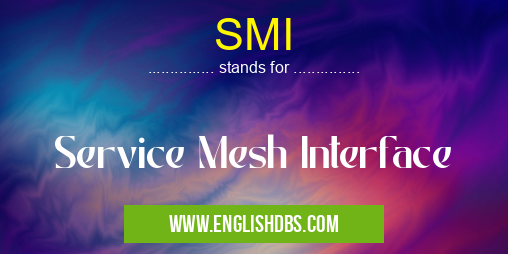What does SMI mean in UNCLASSIFIED
Service Mesh Interface (SMI) is a set of specifications that define how service meshes interact with each other and with external systems. SMI aims to provide a common language and set of interfaces for service meshes, making it easier to build and manage multi-mesh environments.

SMI meaning in Unclassified in Miscellaneous
SMI mostly used in an acronym Unclassified in Category Miscellaneous that means Service Mesh Interface
Shorthand: SMI,
Full Form: Service Mesh Interface
For more information of "Service Mesh Interface", see the section below.
What is SMI?
SMI is a collection of specifications that define:
- Service discovery: How service meshes discover and register services.
- Traffic management: How service meshes route traffic between services.
- Telemetry: How service meshes collect and export metrics and logs.
- Security: How service meshes secure communication between services.
Benefits of SMI
SMI provides several benefits, including:
- Interoperability: SMI enables different service meshes to work together seamlessly, regardless of their implementation.
- Portability: Service meshes that implement SMI can be easily deployed across different environments, such as on-premises, cloud, and hybrid.
- Extensibility: SMI allows for the development of new and innovative service mesh features and extensions.
Essential Questions and Answers on Service Mesh Interface in "MISCELLANEOUS»UNFILED"
What is Service Mesh Interface (SMI)?
SMI is a set of open-source specifications and tooling for building and operating service meshes on Kubernetes. It provides a common interface for service mesh components, enabling interoperability between different implementations.
What are the benefits of using SMI?
SMI offers numerous benefits, including:
- Interoperability: It allows different service mesh implementations to communicate and work together seamlessly.
- Simplified management: It provides a unified interface for managing and configuring service meshes, reducing complexity.
- Extensibility: SMI allows for the addition of custom functionality and integrations through plugins and extensions.
What are the key components of SMI?
SMI consists of three main components:
- Control plane: Manages the service mesh and implements its core functionality.
- Data plane: Handles network traffic and enforces security and observability policies.
- APIs and Interfaces: Defines the communication channels and data formats used by the control and data planes.
How is SMI used in practice?
SMI is widely used in cloud-native environments to:
- Implement service-to-service communication: Establish secure and reliable connections between microservices.
- Enforce traffic policies: Control the flow of traffic within the service mesh, routing requests and managing load balancing.
- Provide observability: Collect metrics and trace data to monitor the health and performance of the service mesh.
Final Words: SMI is a key technology for building and managing modern, distributed systems. By providing a common language and set of interfaces for service meshes, SMI makes it easier to create and manage scalable, reliable, and secure multi-mesh environments.
SMI also stands for: |
|
| All stands for SMI |
